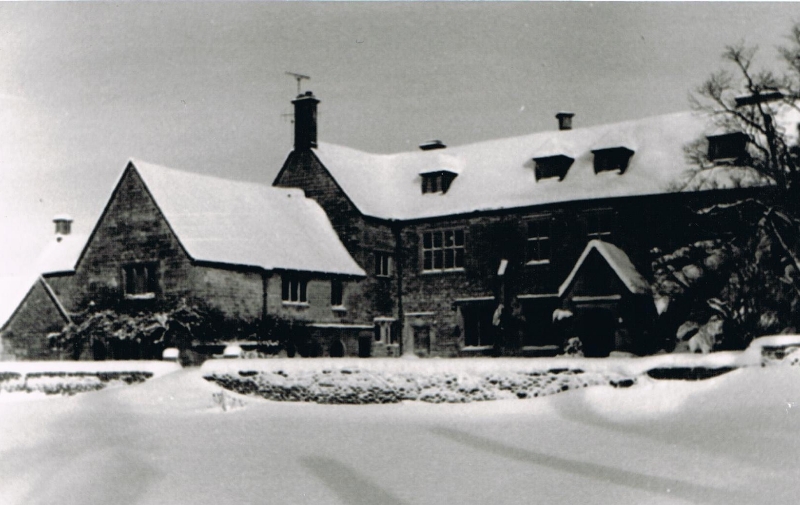Explanatory Note: This short section describes some of the homes, farms and regions where so much of the life of the Molteno, Murray, and Anderson families took place during the 19th and first half of the 20th centuries. In some cases, you can click on the place and you will find much more detail about it.
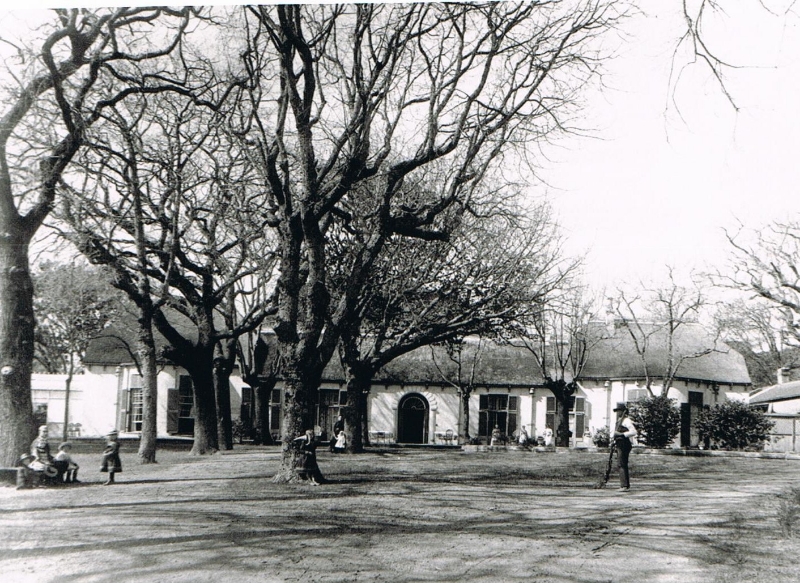
Claremont House, view from the oak avenue, 1886
By the early 1860s, John Charles Molteno had been building up his big sheep farming operation at Nelspoort (see below) for twenty years. Now nearly fifty and involved in politics as a Member of the Cape Parliament, he felt it would be more convenient to have his main home in Cape Town. This is where he had been based from 1831 for the first ten years of his life in the Cape. So after careful casting around, he eventually bought Claremont House. This property lay about six miles from the centre of Cape Town. It comprised a large house and an estate of some 140 acres. And when his daughters, Caroline (in 1876) and Maria (in 1879) got married, John Charles built two houses on the estate for them to live in initially – Greenfield House and Barkly House. Following his death in 1886, Frank Molteno has his wife, Ella Jones, eventually took the main house over. But as the years went by, parcels of land were sold off and became the surrounding suburbs of Harfield Road and Claremont. Claremont House itself, and what land remained, were eventually sold in 1929 and the house subsequently demolished. But for sixty years, Claremont House was the main point of reference in Cape Town for the family, along with the eventual home of Caroline Murray and her husband Dr C F K Murray, Kenilworth House.
East Griqualand
This region of the former Cape Colony lies at its eastern side between the Transkei and Kwazulu Natal. Several segments of the family farmed there throughout the 20th century – notably Gordon Murray (one of Dr C F K Murray and Caroline Molteno’s sons); Harold Anderson (a son of Thomas Anderson and his wife Maria, Maria being John Charles Molteno’s third daughter); and Eliot Stanford and his wife Effie Anderson (Effie being Harold’s sister).
Elgin, Western Cape
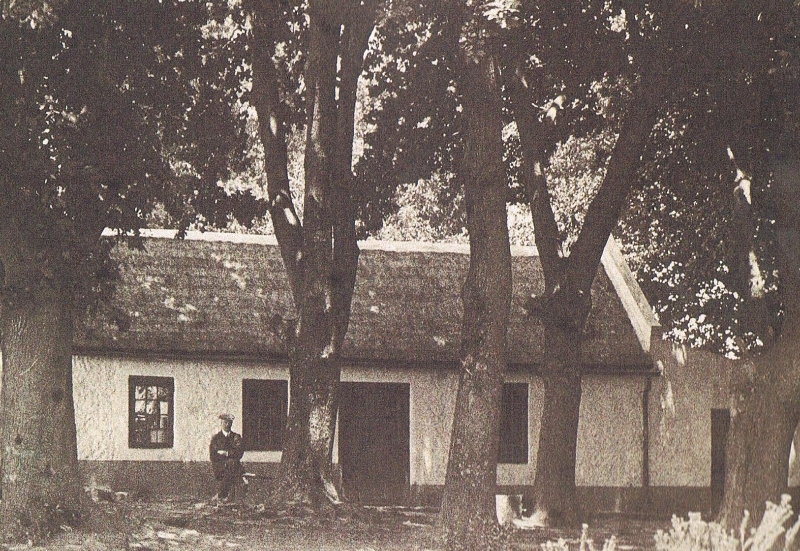
Ted and Harry Molteno’s first house, 1903
This upland area beyond the Hottentots Holland Mountains lies about 40 miles from Cape Town. Several members of the family bought land and retirement homes there around 1900 – including Dr C F K Murray and his wife Caroline Molteno; Frank Molteno and his wife, Ella Jones; and John Charles Molteno’s two youngest sons, Ted and Harry Molteno. This is where the latter pioneered the growing of apples and deciduous fruits of all kinds and began what to this day is South Africa’s huge fruit export business. Several branches of the family – Moltenos, Murrays and Pares — live and farm there to this day.
Glen Lyon, Scotland
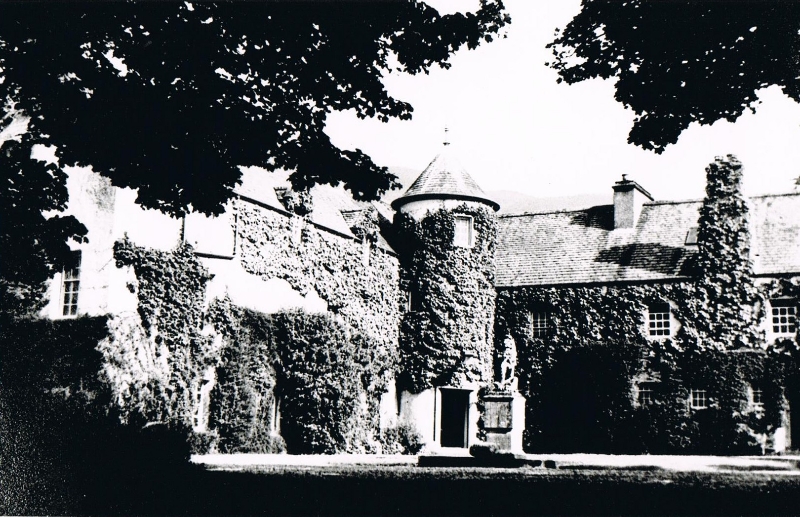
Glen Lyon House
Sir Donald Currie, the founder of what became the Union Castle Company which ran the mail boat service between England and the Cape, bought three neighbouring estates in the Scottish Highlands in the 19th century, each destined for one of his daughters. Glen Lyon was bought by him in 1885 and became his daughter, Bessie’s, following his death in 1909. From then on, it became the Scottish home of her and her husband, Percy Molteno. When Percy died in 1937, his son, Jervis Molteno, and his wife Islay Bisset, took it over. Throughout the 20th century, Jervis and Islay continued the tradition of welcoming all their relations and Glen Lyon remained the Scottish centre of the Molteno family’s life. Although the house was sold in the 1980s, several of Jervis and Islay’s descendants, in particular their daughter, Dierdre Molteno and her husband, Dr Michael Riddell’s offspring still live in the area of Glen Lyon, including the Chesthill Estate in the Glen itself, and see themselves as Scottish.
Inungi farm, East Griqualand
This is the farm which Elliot inherited from his father, and where he and his wife, Effie Anderson, settled after their marriage. Effie was Thomas Anderson and Maria Molteno’s only daughter, and so a granddaughter of John Charles Molteno. Effie’s daughter, Cynthia, has written extensively about her growing up at Inungi in the 1920s & 1930s (see her descriptions in the Diaries & Reminiscences section of the website). Her father, Eliot Stanford, who lived to be over a hundred, continued to farm Inungi until quite late in the 20th century. See also East Griqualand here.
Kalk Bay, Cape Peninsula
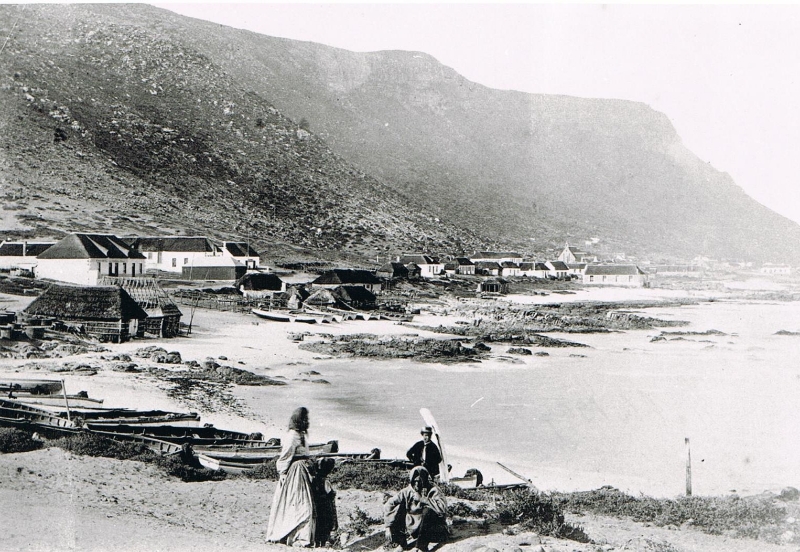
Kalk Bay, late 19th century
This tiny fishing village and harbour in False Bay lies about 15 miles down the Cape Peninsula from the central Cape Town. In 1870, John Charles Molteno and his wife, Elizabeth Maria Jarvis, who had already made their main home at Claremont House, bought a little cottage above Kalk Bay. From then on, it became a favourite summer holiday place for the family. Tom Anderson and his wife, Maria Molteno (the youngest of John Charles’s daughters) moved there from Kenilworth after Tom’s Bank went bankrupt in 1891. And in the early years of the next century, several other members of the family built holiday homes in the vicinity, including Nellie Bisset and her husband, and Wallace Molteno and his wife, Lil Sandeman, who spent part of each summer there. Frank Molteno built a house for Ella and himself at St James next door to Kalk Bay, where James Molteno also had a house for some years.
Kamferskraal, the Karoo
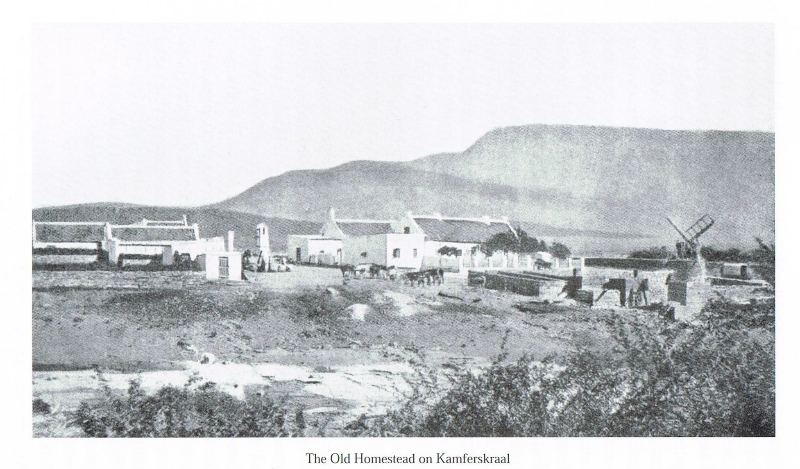
Kamferskraal — the old homestead
This farm was one of the farms John Charles Molteno bought as part of his Nelspoort Estate (see Nelspoort). His son, Wallace Molteno, farmed it for some thirty years; he and his wife, Lil Sandeman, only moved their home from Kamferskraal to the main farm, Nelspoort, in 1918. Kamferskraal was eventually sold, some years after their deaths, in the early 1940s.
Kenya
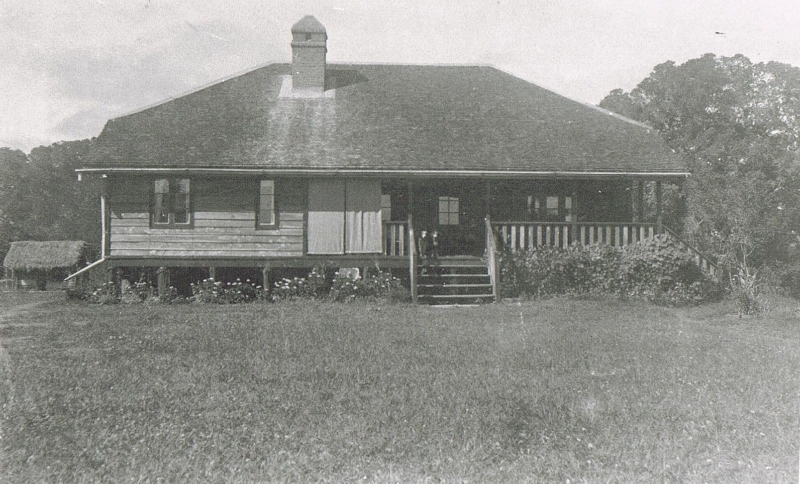
Jarvis Murray’s farmhouse, Kenya, c. 1920
Kenya became Britain’s most important East African colony from the beginning of the 20th century. This was partly because the climate of its Highlands around Mount Kenya was conducive to British settlement and farming activities. Two of Dr C F K Murray and Caroline Molteno’s sons, Jarvis and Lenox, moved there in the early 1900s. They were employed surveying African lands with a view to their being made available to British immigrants. When World War 1 broke out in 1914, both brothers joined up and spent the whole war fighting the German forces in neighbouring German East Africa (today’s Tanzania, Rwanda and Burundi). Jarvis farmed in Kenya for some years after the end of the War, but eventually decided to leave the territory. Lenox also continued to make Kenya his home for a short while after 1918. But when he married Margaret Molteno, her father gave them Painswick Lodge in Gloucestershire, and they lived there. But Lenox kept his farm in Kenya, and moved between there and England throughout his life. His son, George Murray (and his sons) still farm there today – at Marania and Lolomarik.
Miller’s Point, Cape Peninsula
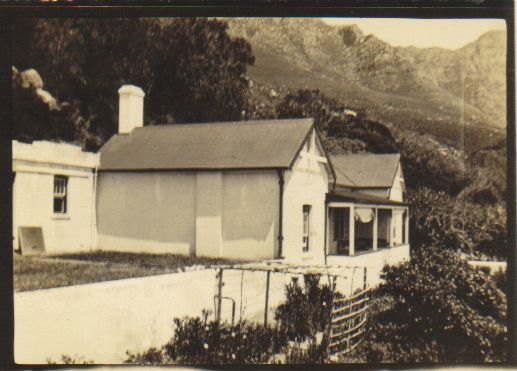
Millers Point, the house above the beach, early 1900s
This lovely solitary house, with the mountain towering immediately behind and overlooking its own little private beach below, is situated a few miles beyond the naval base of Simonstown. Some 20 miles from Cape Town, and beyond where the railway ends even today, it was only reachable along a rough track when Percy Molteno bought it in the 1890s as his family’s Cape home. For two generations (until it was sold in 1962), Miller’s Point was his and Bessie’s summer home when they visited the Cape. They, and their son Jervis Molteno and his wife, Islay Bisset, after them, generously made it available for other members of the family, Moltenos, Murrays, Stanfords and Bissets, to enjoy.
Nelspoort, the Karoo
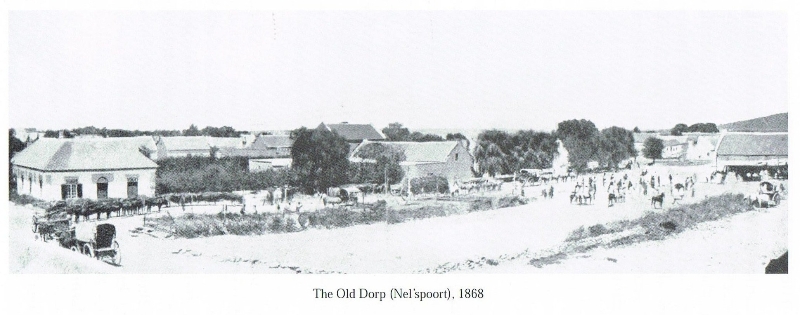 Situated in the heart of the Karoo, and about 30 miles beyond what was in the mid 19th century the tiny village of Beaufort West, Nelspoort was the area where John Charles Molteno bought a succession of farms from the early 1840s. This was where he built up his big merino sheepfarming operation. He quite soon involved his first cousins, Henry and Arthur Jackson, who come out to the Cape to help manage the farms. Jacksons cousins were involved with the Nelspoort farms as managers and part owners four a couple of generations. And Jacksons still farm in the vicinity at Three Sisters to this day. Following John Charles Molteno’s death in 1886, his son, Charlie, took over the main responsibility for many years. Eventually in 1918, his younger brother, Wallace Molteno and his wife, Lil Sandeman, took over. The farm remained in the family’s hands until sold in the early 1940s. For a century, Nelspoort was a major centre for the family, with a succession of relatives always welcome to come and stay.
Situated in the heart of the Karoo, and about 30 miles beyond what was in the mid 19th century the tiny village of Beaufort West, Nelspoort was the area where John Charles Molteno bought a succession of farms from the early 1840s. This was where he built up his big merino sheepfarming operation. He quite soon involved his first cousins, Henry and Arthur Jackson, who come out to the Cape to help manage the farms. Jacksons cousins were involved with the Nelspoort farms as managers and part owners four a couple of generations. And Jacksons still farm in the vicinity at Three Sisters to this day. Following John Charles Molteno’s death in 1886, his son, Charlie, took over the main responsibility for many years. Eventually in 1918, his younger brother, Wallace Molteno and his wife, Lil Sandeman, took over. The farm remained in the family’s hands until sold in the early 1940s. For a century, Nelspoort was a major centre for the family, with a succession of relatives always welcome to come and stay.
In 1923, Margaret Molteno and her husband, Lenox Murray, moved from Tulbagh in the Western Cape where they had had an unhappy time trying to farm just after their marriage, and settled in England. Margaret’s parents, Percy Molteno and Bessie Currie, bought Painswick Lodge and its farm for them. Perched on the edge of beautiful Cotswold country just above the valley of the Severn, Painswick Lodge became one of the main centres for family hospitality, particularly after Percy’s death in 1937 led to the disposal of his home in London (Palace Court) and Parklands in Surrey. Painswick Lodge is still in the hands of the family (as of 2012).
Palace Court, London

Percy and Bessie Molteno outside 10 Palace Court, London W.1, 1912
Sir Donald Currie commissioned the young Scottish architect, James Maclaren, to build two adjoining houses in 1889 as London homes for his daughters. Once complete, Percy Molteno and his wife, Bessie Currie, moved in, and for nearly 50 years it became their London base. This was particularly convenient for Percy during his time as a Director of the Castle shipping line that his father in law, Sir Donald Currie, had built up; and during his time as a Liberal Member of Parliament (1906-1918). Percy and Bessie made their London home, as well as their other homes, Parklands just south of London in Surrey and Glen Lyon in Scotland, always open to visiting members of the far-flung Molteno, Murray and Bisset families. Situated just north of Kensington Gardens in the heart of the West End, this beautiful Arts and Crafts movement house is a rare example of Maclaren’s work.
Parklands, Surrey
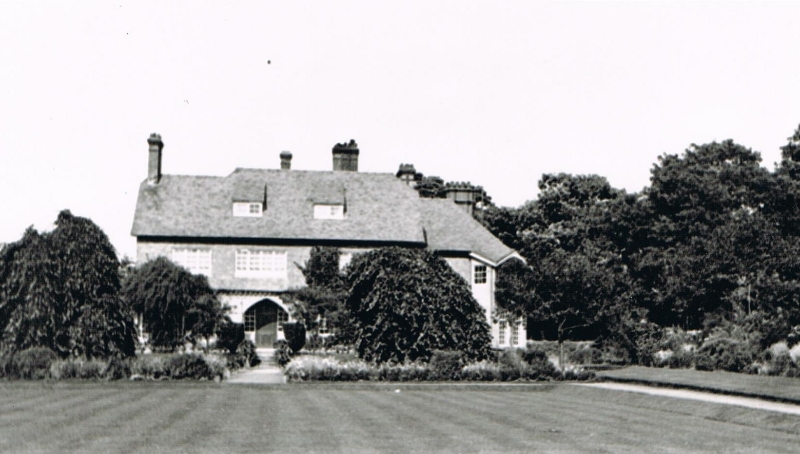
Parklands, Shere in Surrey
This farm was bought by Percy and Bessie Molteno in the early 20th century as their nearby retreat from Central London. It is situated on the hills just above the pretty villages of Gomshall and Shere in Surrey. Percy took a close interest in the farming activities which included supplying fresh fruit and vegetables to the family at Palace Court in London. The house still stands today, its exterior not greatly changed.

